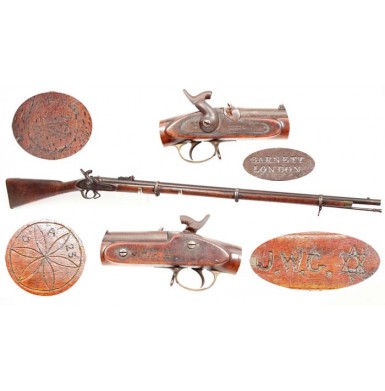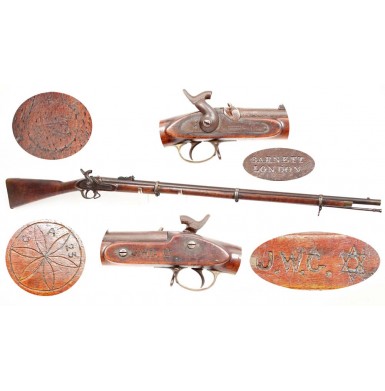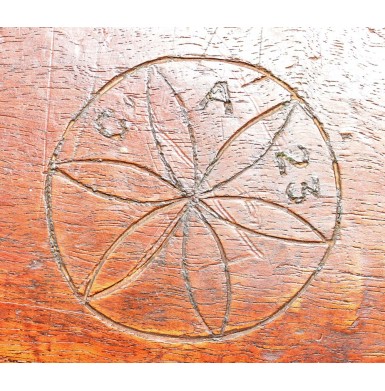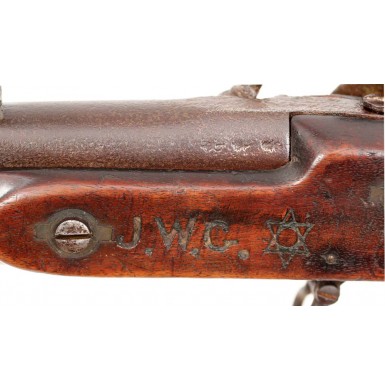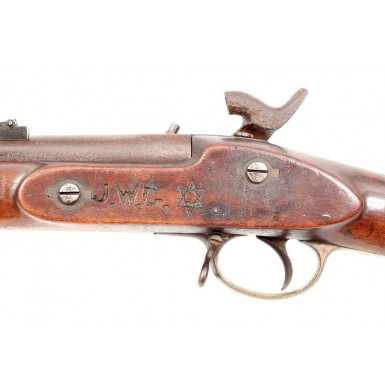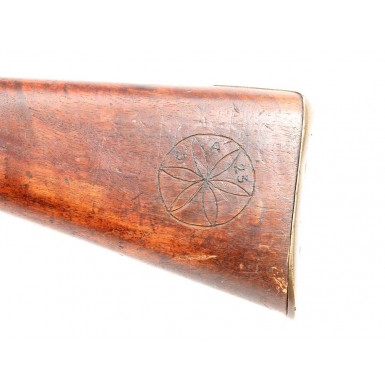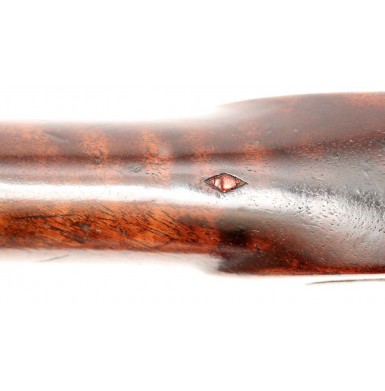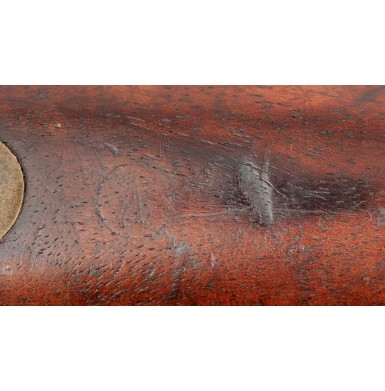Confederate P-1853 Identified to 23rd LA Infantry
- Product Code: FLA-2875-SOLD
- Availability: Out Of Stock
-
$1.00
There is no English gun maker who could more appropriately be called the “Gun Maker to the Confederacy” than the London firm of John Edward Barnett & Sons. During the course of the American Civil War, Barnett delivered thousands of P-1853 “Enfield” rifle muskets, as well as P-1853 artillery and P-1856 cavalry carbines to the Confederacy. Barnett not only filled Confederate central government contracts, but also orders for the Confederates states of Georgia, North Carolina, South Carolina and Louisiana. The Barnett family traced their gunmaking heritage to Thomas Barnett who operated in London as early as 1796. In 1811 the firm became Thomas Barnett & Sons, and John Edward Barnett subsequently succeeded to the business in 1833. In 1842 the firm was renamed JE Barnett & Sons and operated under that name until 1901 when they became JE Barnett & Sons LTD, going out of business in 1908. During the Civil War years, the Barnetts operated at both their 134 Minories address, which had been established in 1833, and at Brewhouse Lane, Wapping, where they operated from 1860-1874. In the typical fashion of the old time gunmakers in England, Barnett relied heavily on a variety of contractors to produce piecework parts, which were subsequently assembled into complete arms in the Barnett shop. While Barnett could clearly manufacture entire guns in house (and often did), it was often more expedient and cost effective to sub-contract for major components when large contracts were received and had to be delivered quickly. Many of the orders received from the Confederacy during the course of the American Civil War were just these types of orders, which had to be completed as quickly as possible. It is not uncommon to disassemble a P-1853 rifle musket with a Barnett marked lock, only to discover that the gun may have been assembled by Barnett, but that few (if any of the components) were actually produced by Barnett. These guns often bear Confederate viewers marks such as the small CH/1 in circle, a JS in a circle (either block or script letters), or one of the known marks of Sinclair, Hamilton & Company “ a primary supplier of English arms and materiel to the Confederacy. Even those Barnett arms devoid of documented Confederate inspection marks are often Confederate related arms. Barnett delivered a number of guns, presumably to the Confederacy, that were assembled by other makers, but are marked BARNETT / LONDON either on the stock flat opposite the lock or along the toe of the stock. These were clearly guns purchased by Barnett to get a nearly completed order “out the door” as expeditiously as possible. Sometimes the presence of a previously undocumented mark on a Barnett Enfield suggests Confederate use as well.
This particular P-1853 Enfield Rifle Musket by Barnett is marked with the enigmatic Confederate inspection mark JS within a small circle on the top of the stock comb, just forward of the brass buttplate tang. This is the same location, size and style of mark that contains the CH / 1 inspection mark of Curtis & Hughes, two English inspectors who viewed Barnett delivered arms for the Confederacy. It is reasonably extrapolated that the same style and location of mark, containing the letter “JS’ (either in block or script form) represent the work of an inspection team under the supervision of John Southgate, whose initials also appear in the JS / Anchor viewers’ mark. There is not doubt in my mind that this is a Confederate inspected P-1853 Enfield Rifle Musket. The Confederate attribution becomes even stronger when the carvings found on the stock are examined. The stock flat, opposite the lock is carved with the initials J.W.G., as well as with a six-pointed star (hexagram) with a circle in its center. The reverse buttstock is carved with a pattern known as the “Flower of Life”, and is carved with the unit information Co A 23 between the flower petals. This combination of unit markings, initials, and symbols almost certainly identify the musket to Jules Wiatt Gautier of Company A, 23rd Louisiana Infantry. After significant research, only three Confederate soldiers were found with the initials “JWG” who served in Company A of a 23rd regiment. However, the symbols carved on the stock almost certainly indicate that the musket saw service with the state of Louisiana. The most prominent association is the carved hexagram that appears on the stock flat. Students of Confederate state purchased arms know that the P-1853 Enfield Rifle Muskets purchased directly by the state of Louisiana were typically marked with a pair of six-pointed stars in the wood behind the triggerguard, with the letter “L” in their center. This same hexagram symbol appeared on the shipping crates for these guns as well. After examining documents within the McRae papers, it appears other Louisiana materiel purchased from Barnett, such as smoothbore muskets, were also delivered in crates marked with a hexagram. The choice of the hexagram as a mark for Louisiana imported arms has long confounded researchers, but a potential answer may be found in the fact that this musket is also carved with a “Flower of Life” symbol. The “Flower of Life” is a symbol of perfection that dates back to per-Christian times. The symbol is actually formed by drawing 12 identically sized circles whose edges all make contact a single central point, and then drawing a 13th circle of the same size, whose center is the contact point of the 12 other circles. By looking at the lines that form the flower petals, and by imagining the circles described by the arcs that are each side of a petal, the entire 13-circle image can be visualized. The hexagram is also an equally ancient symbol of perfection, often being described as the perfect union of man and woman, equal amounts of fire and water or a balance of good and evil; much like the Asian Yin & Yang symbol. These symbols are often referred to as “sacred geometry”. Over the centuries, these ancient symbols of perfection have been woven into the fabric of many cultures and religions, and even Masonry. The symbols are often encountered in the folk art of the Pennsylvania Dutch region of America. The connection to Louisiana lies in this Pennsylvania association. During the American colonial period, and well into the early Napoleonic period, America was a regular destination for French Huguenots escaping from France. The Huguenots were religious Christian separatists who were escaping Catholic persecution in France. Thousands came to America to practice their sect of Presbyterian Christianity. Initially, many found a home in the Pennsylvania-Dutch region of Pennsylvania, where their religious ideas were tolerated and accepted by the local inhabitants. Over decades, many of the symbols found in the local folk art and religious expression found their way into American French Huguenot culture. When Napoleon sold Louisiana to the United States, many French Huguenots moved there to reestablish their connection with the French roots of their home country, while simultaneously enjoying the religious freedom of the United States. As they moved, they brought the cultural influence of the Pennsylvania Dutch with them, and that influence remained with the French Huguenots in Louisiana. The governor of Louisiana during the majority of the American Civil War was Thomas Overton Moore (governor from January 1860-January 1864). Moore was a Presbyterian and appears to have descended from a French Huguenot family that moved to Louisiana circa 1820. I believe that the cultural influence of his French Huguenot family and the influence of French Huguenot culture in New Orleans may have had some effect on the symbols that he chose to represent military arms purchases for the state. It appears that Jules Wiatt Gautier was also descended from French Huguenots, so his choice to use both a hexagram and a Flower of Life to decorate his Enfield make perfect sense. Little is know of Gautier, other than he appears to have been born in France circa 1835 and emigrated to America with his parents Jean Jacques and Marie) in 1839, likely to enjoy religious freedom. The family settled in New Orleans upon their arrival. Gautier apparently became a carpenter as a young man, as that occupation is listed on his Confederate muster sheets. Gautier entered Confederate service at Camp Lewis in New Orleans, on September 10, 1861 by joining Captain F. Gomez’s company (1st, unattached), which was part of the Orleans Battalion of Louisiana Artillery. Captain Gomez’s company was re-designated Company A of the 23rd Louisiana Infantry in January of 1862. Company A spent their service (along with companies B, C & D) at Fort Livingston, which was one of the coastal forts defending New Orleans. The balance of the companies from the 23rd LA were stationed at Forts Guion, Lafourche, Pike, Quitman and Jackson. With the fall of New Orleans in late April of 1862, and General Quitman’s order to evacuate New Orleans, the various companies of the 23rd Louisiana Infantry were told they were going to have to join Confederate forces fighting outside the state of Louisiana. The 23rd LA was ordered to Vicksburg, MS, but the regiment essentially disintegrated with the majority of the men simply going home and refusing to fight outside of the state. Some elements of the 23rd LA did make it to Vicksburg, where they were combined with other remnants of Louisiana regiments (including the 3rd LA, 17th LA, 21st LA, 26th LA, 27th LA, 28th LA & 31st LA), many of which had also been manning posts within the state, and in January of 1863 the reorganized regiment was officially designated the 22nd Louisiana Infantry. All of the Confederate records for the 23rd LA Infantry are found within those of the 22nd LA Infantry, and the muster cards for those soldiers who served in the 23rd are usually headed “22nd LA Infantry (formerly 23rd LA Infantry)”. After the 23rd LA dissolved, Gautier returned home to New Orleans and there married Irma, who would bear him three children: Victoria, Rosalie and Leon, who were born in 1863, 1865 and 1868. Gautier appears to have continued to work as a carpenter and lived to the age of 60, dying July 11, 1895. It appears that Gautier brought his musket home with him when he abandoned his post at Fort Livingston, which likely accounts for its fairly complete, yet well used condition.
This “Block JS’ in a Circle Marked Barnett contract P-1853 Rifle Musket is in about VERY GOOD condition overall and is very attractive. The wood of the musket is in slightly better condition than the metal of the gun. The gun is clearly marked on the lock BARNETT / LONDON forward of the hammer without the sometimes encountered additional mark of a (CROWN) / TOWER to the rear of the hammer. The interior of the lock is marked with the initials J.M. upside down, over the mainspring, and with the number 7 on the interior of the lock plate and on the inside neck of the hammer. These are assembly marks placed there by the lock maker. The bottom edge of the lock has the file slash mating mark | |, a mark that is found throughout the musket on major components. The barrel is marked at the breech with three London commercial proofs: a Provisional Proof, a Definitive Proof and a Definitive View mark. The proofs are slightly weak due to percussion cap erosion around the breech of the musket. The underside of the barrel is marked with a plethora of initials, names and numbers, including the gauge mark 25 (indicating .577 caliber), the initials J.B., B, J.M. (as found in the lock), and J.F.. The mating mark | |, and the names BARNETT and FAULKNER. are present as well Most of the marks are the initials of workmen, such as the rough finisher and polisher of the barrel, the “setter up” of the gun, and maybe even the rough stocker. The name “Faulkner” is that of the barrel maker. The Faulkner Brothers, David & Charles, were a major Birmingham gun barrel making company, operating from 1851-1869 at 38 Great Lister Street. As noted the | | mating mark appears on the lower edge of the lock and under the barrel, as well as in the ramrod channel of the stock and neck of the breech tang screw. No mating marks are visible on two lock mounting screws.
The gun is in about VERY GOOD overall condition and is essentially untouched, with a lovely dark brown, oxidized patina on the exposed surfaces of the barrel, which is mixed with some very faint traces of the original blued finish. The metal is mostly smooth, with some scattered areas of minor oxidized roughness over all of the iron surfaces mixed with some lightly scattered pinpricking. There is more moderate pinpricking and light pitting around the breech and bolster area from percussion cap flash. The bore of the gun is in about GOOD condition, with faint (but visible) rifling along its length, which is stronger near the breech than at the muzzle. The bore is mostly dark, and shows moderate pitting along its entire length, with some more significant patches of pitting present closer to the muzzle. The last 1" of the bore, closest to the muzzle has been bored smooth. It is not clear if this was done as a sort of "false muzzle" for the purposed of starting a bullet when hunting, or if Gauthier thought about having the gun bored out to serve as a fowler and changed his mind at the last minute. The lock of the gun is mostly smooth metal, with some minor surface oxidation present. It has a thick plum brown patina that matches the balance of the gun wonderfully. The lock is excellent mechanically and functions well on all positions. The head of the hammer screw is damaged, and half of the head is missing. The wear and patina of the screw suggest that the damage to the hammer screw is very old and likely from the period of use. The gun retains a complete, original rear sight, however it appears to have been reattached to the barrel at some point in time. As the sights were only silver soldered to the barrel, it is not uncommon for them to be knocked loose over a period of 150 years. The musket retains its original front sight/bayonet lug. The gun retains both sling swivels as well. Both appear to be original period swivels, but may be replacements added to the gun to make it more complete. The upper two barrel bands appear to be original to the musket, but the lower barrel band is almost certainly a replacement. Although the lower band is an original and correct Palmer patent P-1853 Enfield clamping barrel band, it appears that this musket spent much of its life with a US M-1816 or M-1842 style barrel band in the lower position. This is indicated by the wear and patina of the stock in that area, clearly showing the outline of a US style band (with extended forward lip), etched into the wood (see the pictures below). The original Enfield band was likely added during the last 50 years to make the gun more correct in appearance. The original full-length ramrod is in the channel under the barrel and retains good threads at the end. The brass furniture has a lovely ochre patina, and is very attractive. The stock is in NEAR FINE condition. The wood to metal fit of the gun is wonderfully executed throughout, with no slop or gapping present. The stock is full-length, solid, and free of any breaks, or repairs. The stock retains very sharp lines throughout and crisp edges, with no indication of having been sanded. Any of the minor rounding to sharp edges appears to the result of actual carry and use. The wood has a wonderful polished patina that is not unlike a banister that has been rubbed by hands for more than 100 years. The rifle does show a number of bumps, dings and minor dents in the wood, as would be expected from a 150 year old military musket, but the wood remains very crisp and sharp overall. There is a minor grain crack to the rear of the lock mortise, but this is small and stable and does not appear to be structural. As noted earlier, the Confederate inspection mark of a JS within a small circle is present on the top of the stock comb, forward of the buttplate tang. The stock flat opposite the lock is carved with the initials J.W.G. and with a hexagram with a circle in its center. The reverse buttstock is carved with a neatly executed “Flower of Life”, with the inscription Co A 23 between the petals. One additional decoration is carved into the wrist of the stock; a diamond with a small symbol within it. The center of the diamond is painted with a reddish paint that appears period.
Overall, this is a very nice example of a scarce “Circle-JS’ inspected Barnett contract P-1853 Enfield rifle musket, identified to Jules Wiatt Gautier of the 23rd (22nd) Louisiana Infantry Company A. The gun has tons of eye appeal, is much crisper and sharper than most Enfields offered for sale these days, and was made by one of the most famous English gun makers to sell arms to the Confederacy; JE Barnett & Sons. This is simply a wonderful gun with scarce marks and a nice Confederate attribution that will almost certainly be a great addition to a collection of identified arms or Civil War Enfields. A small folder of information accompanies the musket, including Gautier’s Confederate service records.
SOLDTags: Confederate, P, 1853, Identified, to, 23rd, LA, Infantry

